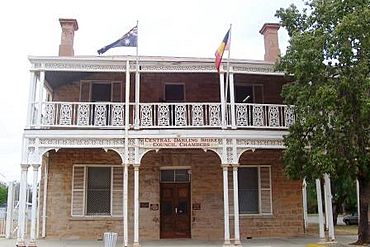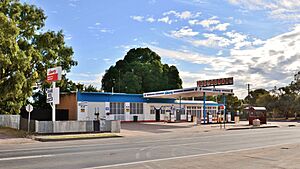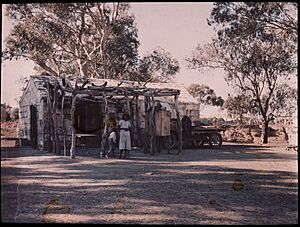Wilcannia facts for kids
Quick facts for kids WilcanniaNew South Wales |
|||||||||
|---|---|---|---|---|---|---|---|---|---|

Central Darling Council Chambers
|
|||||||||
| Population | 735 (2021 census) | ||||||||
| Established | 1866 | ||||||||
| Postcode(s) | 2836 | ||||||||
| Elevation | 75.0 m (246 ft) | ||||||||
| Location |
|
||||||||
| LGA(s) | Central Darling Shire | ||||||||
| County | Young County | ||||||||
| State electorate(s) | Barwon | ||||||||
| Federal Division(s) | Parkes | ||||||||
|
|||||||||
Wilcannia is a small town located within the Central Darling Shire in north western New South Wales, Australia. Located on the Darling River, the town was the third largest inland port in the country during the river boat era of the mid-19th century. At the 2021 census, Wilcannia had a population of 735.
Contents
History
The area lies in the traditional lands of the Barkindji people, who call the river "Baaka". The name Wilcannia is said to be derived from an Aboriginal term for either "gap in the bank where floodwaters escape" or "wild dog". Neither meaning has been linguistically verified.
In 1835, explorer Major Thomas Mitchell was the first European to the region, in which he traced the Darling River to what is now Menindee. In June 1866, the township of Wilcannia was proclaimed. In 1871, the population was 264, and grew to 1,424 by 1881. During the 1880s, Wilcannia reached its peak, and had a population of 3000 and 13 hotels and its own newspaper, the Western Grazier. It was, with Wentworth, Echuca, Mannum and Goolwa, one of the major Murray-Darling river ports which played a vital part in the transport of goods, notably wool and wheat, in the days of the paddle-steamers.
A visitor to the town described the river scene in 1890.
Geography
Wilcannia is located where the Barrier Highway crosses the Darling River, 965 kilometres (600 mi) from Sydney. The environment is borderline semi-arid to desert with an annual rainfall of 255 millimetres (10.0 in). Wilcannia is located within the Darling Riverine Plains Bioregion (IBRA classification, Department of Environment), consisting of landscapes adapted to flooding. Common species include River Red Gum, Yellow Box, Oldman Saltbush and Lignum.
The surrounding area is very sparsely settled by pastoralists who have large land holdings, used primarily to run sheep. These holdings fall in the Western Division and the majority are held as 99-year leases.
Climate
Wilcannia has a semi-arid climate with hot summers and mild to cool winters. Mean maximum daily temperature in summer is 34 °C and in winter is 19 °C. The highest temperature recorded in Wilcannia was 50.0 °C (122.0 °F) on 11 January 1939. This was during the severe heatwave of January 1939.
| Climate data for Wilcannia (Reid Street) | |||||||||||||
|---|---|---|---|---|---|---|---|---|---|---|---|---|---|
| Month | Jan | Feb | Mar | Apr | May | Jun | Jul | Aug | Sep | Oct | Nov | Dec | Year |
| Record high °C (°F) | 48.2 (118.8) |
47.1 (116.8) |
44.4 (111.9) |
38.4 (101.1) |
31.3 (88.3) |
29.3 (84.7) |
30.6 (87.1) |
32.4 (90.3) |
39.4 (102.9) |
40.7 (105.3) |
45.2 (113.4) |
46.8 (116.2) |
48.2 (118.8) |
| Mean daily maximum °C (°F) | 35.4 (95.7) |
34.6 (94.3) |
31.3 (88.3) |
26.2 (79.2) |
21.2 (70.2) |
17.7 (63.9) |
17.1 (62.8) |
19.5 (67.1) |
23.5 (74.3) |
27.4 (81.3) |
31.2 (88.2) |
33.9 (93.0) |
26.6 (79.9) |
| Mean daily minimum °C (°F) | 19.8 (67.6) |
19.3 (66.7) |
16.2 (61.2) |
11.7 (53.1) |
7.9 (46.2) |
5.4 (41.7) |
4.2 (39.6) |
5.6 (42.1) |
8.4 (47.1) |
12.2 (54.0) |
15.6 (60.1) |
18.2 (64.8) |
12.0 (53.6) |
| Record low °C (°F) | 9.2 (48.6) |
8.8 (47.8) |
6.4 (43.5) |
1.8 (35.2) |
−2.5 (27.5) |
−2.8 (27.0) |
−5.0 (23.0) |
−3.3 (26.1) |
−0.5 (31.1) |
3.4 (38.1) |
3.9 (39.0) |
8.4 (47.1) |
−5.0 (23.0) |
| Average rainfall mm (inches) | 25.9 (1.02) |
26.5 (1.04) |
24.7 (0.97) |
17.1 (0.67) |
23.6 (0.93) |
22.2 (0.87) |
18.4 (0.72) |
17.5 (0.69) |
15.9 (0.63) |
25.2 (0.99) |
20.9 (0.82) |
26.0 (1.02) |
263.9 (10.39) |
| Average precipitation days | 2.9 | 2.9 | 2.7 | 2.7 | 4.1 | 4.6 | 4.4 | 4.2 | 3.4 | 4.0 | 3.4 | 3.2 | 42.5 |
| Source: Bureau of Meteorology | |||||||||||||
Significant weather
On 9 November 1950, a severe thunderstorm with damaging winds and large hail the size of cricket balls struck the town. Two people were injured, dozens of homes lost their roofs and nearly every house in town was damaged due to the large hail.
Facilities
Wilcannia Central School includes a pre-school and caters for students up to Year 12 (with the last two years through distance education). At the 2020 ARIA Music Awards, Wilcannia Central School's Sarah Donnelley won Music Teacher of the Year.
Construction work began on the Baaka Cultural Centre in August 2023, on the main road through Wilcannia. Its shape resembles the foot of an emu, and it will function as a tourist centre as well as a gallery for local art and artefacts. Local people are being employed, as well as specialists in stonemasonry and rammed earth construction from South Australia and the NSW south coast. Baaka is the Paakantyi word for the Darling River.
The only local radio station is community radio station Wilcannia River Radio, broadcasting on 103.1 MHz, which has provided factual information and aired discussions about matters such as COVID-19, climate change, and other matters. Other radio stations include Outback Radio 2WEB on 99.9 MHz, ABC Radio National, and ABC Western Plains.
Transport
Public transport
Wilcannia is served by NSW TrainLink coaches between Dubbo railway station and Broken Hill, which stop in town and at the Emmdale Roadhouse down the Barrier Highway. Bus route 595 also connects the town to Broken Hill.
Airport
Wilcannia Airport (IATA: WIO, ICAO: YWCA) is 9 kilometers (6 miles) from the centre of Wilcannia. The airport has an asphalt runway of 3,051 feet and a clay runway of 3,701 feet. It is located at the coordinates 31°31′10″S 143°22′50″E.
Demographics and disadvantage
From the 2016 Census, Wilcannia had a population of 549 with 407 (74.4%) people being of Aboriginal or Torres Strait Islander descent, mostly from the Barkindji nation. Wilcannia has 223 private dwellings. The town was listed as one of the most socially disadvantaged areas of New South Wales according to the 2015 Dropping Off The Edge report.
Predominantly populated by Aboriginal Australians, Wilcannia has received national and international attention for government deprivation of its community's needs, and the low life expectancy of its residents. For Indigenous men, that figure is 37 years of age.
Residents have reported that water quality in Wilcannia is unsafe, leading locals to rely on boxed water transported from Broken Hill, nearly 200 kilometres (120 mi) away. In 2021 the town was one of the worst hit by the COVID-19 pandemic in New South Wales, and the government's refusal to ban tourists from the area to preserve the health of its struggling residents was criticised. In September 2021, the New Matilda website published an investigation into allegations of discrimination against Wilcannia residents during the COVID-19 pandemic, citing leaked documents from Central Darling Shire Council.
In the media
The town's social issues were highlighted in the first episode of a two-part BBC3 documentary made by Reggie Yates, Reggie Yates: Hidden Australia, entitled "Episode 1: Black in the Outback", which was first broadcast online on 16 January 2017. In March 2017 the BBC, in response to complaints about the biased and misleading view portrayed, investigated the claims and suspended the production company pending the outcome of the review. The BBC apologised for allowing the programme to go to air.
In July 2017, ABC Radio National highlighted Wilcannia's positive social aspects in a 6-part series called Positively Wilcannia, produced by the podcast The Real Thing.
During the COVID-19 pandemic in Australia, multiple media outlets highlighted how poor living conditions and overcrowding in houses in Wilcannia resulted in the town having Australia's highest per-capita case rate, with one-sixth of residents testing positive to the virus; about 90% of them were Aboriginal. A parliamentary inquiry into New South Wales' handling of the pandemic was told that community leaders warned authorities a year earlier about how Wilcannia's overcrowding situation could lead to a crisis if the virus entered the town.
| Historical population | ||
|---|---|---|
| Year | Pop. | ±% |
| 1921 | 592 | — |
| 1933 | 623 | +5.2% |
| 1947 | 799 | +28.3% |
| 1954 | 821 | +2.8% |
| 1961 | — | |
| 1966 | 800 | — |
| 1971 | 936 | +17.0% |
| 1976 | 1,023 | +9.3% |
| 1981 | 982 | −4.0% |
| 1986 | 1,048 | +6.7% |
| 1991 | 942 | −10.1% |
| 1996 | 688 | −27.0% |
| 2001 | 685 | −0.4% |
| 2006 | 596 | −13.0% |
| 2011 | 604 | +1.3% |
| 2016 | 549 | −9.1% |
| 2021 | 539 | −1.8% |
| Source: Australian Bureau of Statistics data. | ||
Notable people
- Annie Moysey, known as Wilcannia's Grandmother
- The Wilcannia Mob, a hip hop musical group of five Indigenous Australians
- Owen Whyman, initiator of political party Indigenous-Aboriginal Party of Australia
Gallery
-
from the bed of the Darling River
-
Wilcannia Police Station with Melia azedarach
-
The Bourke-Wilcannia road, near Bourke
See also
 In Spanish: Wilcannia para niños
In Spanish: Wilcannia para niños















